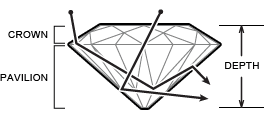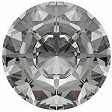Carat weight explained
A carat equals 1/5 of a gram which is a measurement of the diamond’s actual weight and is not relative to its size. A well-cut diamond with a smaller carat weight can appear larger than a higher carat diamond that is poorly cut therefore the Carat weight does not always directly influence how big a diamond will appear.
The size of a diamond is not proportional to its carat weight when compared alongside another diamond. A two carat diamond is not twice as large as a one carat diamond. When rough diamonds are cut and polished into finished diamonds, up to two thirds of the total carat weight may be lost. Since larger rough gems of high quality are found less frequently than smaller rough gems of high quality, a single two carat diamond will be much more expensive than two, one-carat diamonds of the same quality due to the rarity factor.
Prior to the twentieth century, gemstones were weighed using carob seeds, which were small and uniform enough to serve as perfect counter weights on balance scales when weighing a diamond. The word “carob” is the origin of the word “carat” that we use today.
Which Carat Weight Is Right for You?
This is not an easy question to answer. It is a choice that depends on your personal preference and budget. But with our lab grown diamonds you can for example, purchase a 1.00ct diamond for the same price as an 0.80ct earth mined diamond. There are other useful suggestions to help you decide under ‘Which Clarity Grade should I choose’.
When you think about carat weight you should also think about millimeter size and diameters. The following diagram shows the approximate relative size of various carat weights in a round brilliant cut diamond that is cut to the same proportions. As you can see a 2.00ct diamond is not twice the diameter as a 1.00ct diamond, as previously explained.
| 0.50 ct | 1.00ct | 1.50ct | 2.00ct | 3.00ct | 4.00ct | 5.00ct |
 |  | |||||
| 5.1mm | 6.3mm | 7.3mm | 8.0mm | 9.3mm | 10.1mm | 10.8mm |
Colour explained
When we grade colour, the scale relates to ‘colourless’ diamonds. Specifically, the lack of colour in a diamond, the lesser the colour, the higher the grade (& value) of the diamond. The industry standard for colour grading is on a scale of D to Z; with D being absolutely colourless and the highest grade possible to Z having a noticeable degree of colour.
Diamond is composed almost entirely of carbon but do contain traces of other chemical elements. These elements cause diamonds to have background body colours in shades of yellow, grey and brown. (When other chemical elements are present the diamond’s whole colour can change, such as Boron which will create a blue diamond)
When shopping for a diamond, it is generally preferred to choose a stone with the least amount of colour possible, (and what your budget allows). Diamond colour is graded on a scale from D-Z and is divided into five broad categories; colourless, near colourless, faint colour, very light and light yellow. Diamonds come in all colours of the spectrum. The predominant colour you see in an earth mined diamond is yellow, which is caused by the trace element nitrogen. Our lab grown diamonds do not have nitrogen making them ‘whiter and brighter’. Link to 7
Generally, when comparing colour between two diamonds, the diamonds need to be at least two colour grades apart to even begin to see a difference. As you can see from the images below, when diamonds are in the face up position it is almost impossible to see any colour. When viewing the diamond from the side profile, you may start to detect some colour; however, diamonds are admired for their beauty from the face up position and not the side.
Colour grades are established by an experienced diamond grader comparing the diamond in question to a set of specially graded master diamonds, under controlled lighting conditions.
Colourless Diamonds (D-F):
Diamonds within the colourless range are the most rare and valuable of all those on the colour scale. D/E colour stones display virtually no colour, whereas F coloured diamonds will display a nearly undetected amount of colour when viewed face down (side on) by a diamond grader. To the average untrained eye, most people would not detect any colour from D to G-H when looking at a diamond face up.
| D Colour | E Colour | F Colour |
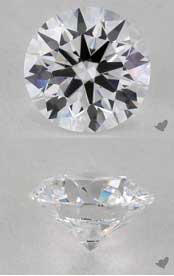 | 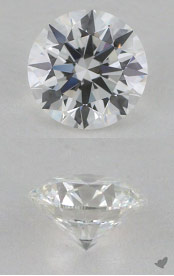 | 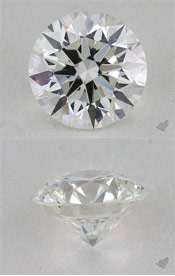 |
Near Colourless Diamonds (G-J):
Diamonds within the near colourless range appear colourless in the face up position but do display a slight amount of colour when viewed face down against a perfectly white background. This trace amount of colour will be undetectable to an untrained eye once the diamond has been mounted. Near colourless diamonds offer a tremendous value for their price.
| G Colour | H Colour | I Colour | J Colour |
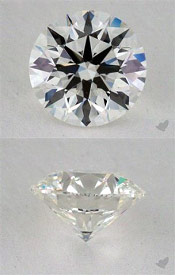 | 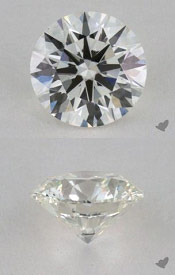 |  |  |
Faint Colour Diamonds (K):
Diamonds within the faint colour category may show a slight hint colour when viewed in the face up position; however, these are another wonderful option for those who are not sensitive to colour.
We do not have many diamonds of these and lower colours.
| K Colour |
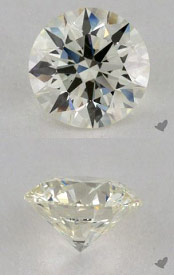 |
Clarity explained
Which Clarity Grade to Choose?
All diamonds have surface blemishes or internal imperfections called ‘inclusions’ by gemmologists. (Some people erroneously call them ‘Carbon spots’ which is technically incorrect as the diamond itself is almost entirely composed of carbon!) Clarity grading involves the combination (or lack of), several overall visual elements to determine the grade. These may include the number of inclusions, the position (e.g. beneath the table, or to the side), and size of the inclusions and blemishes. All these inclusions can occur in both earth mined, and lab grown diamonds. Naturally the fewer and less obvious the inclusions and blemishes, the higher the clarity grade and the value. The GIA (Gemological Institute of America) grades diamonds on a Clarity Grading Scale ranging from Flawless (F) to Included (I3).
It is important to select a diamond that does not have any inclusions that will affect the overall beauty and durability of the diamond. If you want to be 100% sure that your diamond will be completely clean of “eye-visible” inclusions, stick with diamonds graded “VS2” or higher. It is also a good idea to balance the clarity grade of your diamond with the colour. If you are looking at diamonds in the D-F colour range, focus on clarity grades of VS2 or higher. At Adamastar we do not sell diamonds below SI2 clarity grade.
Buying tip: Diamonds in the G-I colour range combined with SI clarity give excellent value for money. The Diamond will still look very white face up and inclusions almost impossible to see with the naked eye.
Cut Explained
The Cut of a diamond does not refer to the diamond’s face up shape such as round or oval. The Cut refers only to the proportions of a round brilliant cut diamond where a skilled diamantaire would use their knowledge and expertise to accurately proportion the stone to maximise the light it reflects, thus unlocking the diamond’s fire and brilliance. Fire is the rainbow flashes of light reflected from within the stone. Brilliance refers to the diamond’s brightness. Of all the Four C’s, Cut has the greatest effect on a diamond’s beauty.
A well-cut diamond will appear very brilliant and fiery, while a poorly cut diamond can appear dark, or grey and lifeless, regardless of its colour or clarity.
Not only do well-cut diamonds appear more brilliant, a well-cut diamond with a smaller carat can appear larger than a higher carat diamond that is poorly cut. Sometimes a cutter will increase the thickness of a diamond’s girdle (as that is the area in a diamond where there is maximum weight gain) in order to get the overall weight of the diamond higher. This results in a diamond with a smaller diameter compared to what it should be for it’s particular weight. This means an ‘ideal’ diamond has both increased brilliance and diameter relative to more a deeply-cut or a thicker girdle diamond.
The GIA Diamond Cut Grade, is only relevant to Round Brilliant Cut diamonds. GIA call this grading system ‘Facetware’ and it has a specific combination of factors which determine the Cut Grade. When it comes to ‘Fancy Cut Diamonds, the criteria for cut is less specific, and is based on several other factors such as how pleasing the outline of the diamond is to the eye, the lack of ‘windowing’ proportion of depth to diameter, and symmetry.
Ideal cut diamonds
An Ideal Cut Diamond is now called ‘Excellent’ by the GIA and refers to a round, brilliant cut diamond that is cut to ideal proportions, angles and can have excellent polish and symmetry ratings. An Excellent diamond is perfectly proportioned to refract maximum light, producing that fire and brilliance up through to the table and crown. Many of our diamonds are classed as 3x (or triple ex), Cut Grade, these being the diamonds that have been cut with superior craftsmanship to achieve a grade of Excellent in its proportions, polish and symmetry. With lab grown diamonds there is little point in going to all the trouble of growing them and not cutting them to the highest standard.
Hearts and Arrows
When a diamond is seen from above with a special Hearts and Arrows viewer, the diamond displays a particular arrow pattern. When turned over and displayed from its pavilion side, the diamond presents the eye with 8 hearts with tiny ‘v’ shapes. Genuine Hearts and Arrows have these patterns visible at a single glance, indicating that the diamond has been cut with perfect optical symmetry and has perfect alignment between crown and pavillion facets.
Many of our diamonds display a true Hearts and Arrows pattern.
Understanding Brilliance, Dispersion & Scintillation
A well-cut diamond exhibits three different optical properties: brilliance, dispersion and scintillation. As light strikes a diamond’s polished surface at an angle, it will either reflect off a facet or the table, or pass through and enter the diamond depending on the angle the light hits the facet. The light that is reflected off the diamond is known as the diamond’s brilliance. As light travels through a stone, some is reflected back, adding to the brilliance. Some of the light rays that enter the diamond is separated into flashes of colour as in a prism. This is known as dispersion. The result of dispersion i.e. the separation of white light into its spectral colours, is known as fire. Scintillation is flashes of colour that are viewable as an observer moves a diamond back and forth.
It is the technical mastering of these precise angles which maximise the three optical properties, which create the stunning visual effect of a round brilliant cut diamond.
Ideal Cut |  | 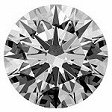 | 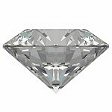 |
Diamonds cut with Excellent to Good proportions allow a maximum amount of light to be returned to the observer and thus have more brilliance and fire.
Too Deep |  | 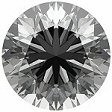 | 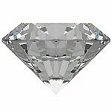 |
A diamond with a deep pavilion will appear dark in the centre of the diamond due to light leakage from the pavilion. Diamonds with a make grading of Fair to Poor will appear like this. Adamastar do not list diamonds with Fair or Poor make.
A diamond which has a spread crown with a shallow pavilion is termed a ‘fisheye’ which shows as a white circle around the inside edge of the table when looking down on the diamond. This is actually the reflection of the girdle. Diamonds with this make are graded Fair to Poor will appear like this. Adamastar do not list diamonds with Good, Fair or Poor make. At Adamastar we only sell diamonds that have either an Excellent or Very Good cut grade.
As previously described, only ‘round’ diamonds have a ‘Cut’ grade. Fancy shapes have different criteria based on ‘pleasing to the eye’ proportions and other criteria.


